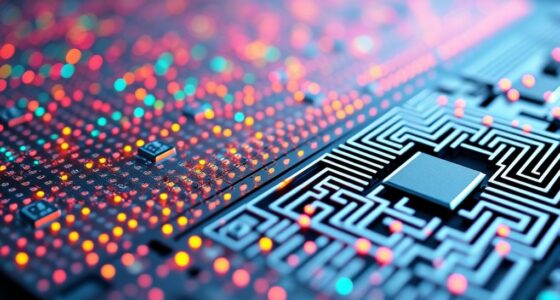Nano-enhanced batteries use advanced nanomaterials to improve energy storage by increasing surface area and conductivity. By designing electrodes at the nanoscale with structures like nanowires or nanoparticles, you can achieve faster charging, longer life, and higher capacity. These innovations also make batteries lighter and more durable, supporting high-performance applications. If you want to discover how nanomaterial fabrication and electrode design work together to revolutionize batteries, keep exploring further.
Key Takeaways
- Nano-enhanced batteries utilize nanomaterials to increase electrode surface area, improving charge capacity and rate performance.
- Fabrication of nanostructured electrodes enhances ion accessibility and reduces degradation, extending battery lifespan.
- Nanoscale engineering creates interconnected networks that facilitate electron transport and mechanical stability.
- Advances in scalable nanomaterial production enable commercial development of faster-charging, higher-capacity batteries.
- Incorporating nanotechnology addresses modern energy demands, supporting applications like electric vehicles and portable electronics.

Nano-enhanced batteries are revolutionizing energy storage by using nanotechnology to improve their performance. When you explore how these batteries work, you’ll find that a key factor is nanomaterial fabrication. This process involves creating materials at an extremely small scale—on the order of nanometers—allowing for unique properties like increased surface area, enhanced conductivity, and better mechanical stability. By carefully designing and synthesizing nanomaterials, scientists can tailor their characteristics to optimize energy storage capabilities. This precise control over nanomaterial fabrication means that the active materials used in the battery can be made lighter, more durable, and more efficient than traditional options.
One of the most significant impacts of nanomaterial fabrication is its influence on electrode design. In nano-enhanced batteries, electrodes are engineered at the nanoscale to maximize their surface area, which directly boosts their ability to store and transfer energy. You’ll notice that by incorporating nanostructured materials—such as nanowires, nanotubes, or nanoparticles—the electrodes become more porous and accessible, allowing ions to move faster and more freely within the battery. This not only improves charge and discharge rates but also extends the overall lifespan of the battery. The electrode design at the nanoscale also helps mitigate common issues like volume expansion during charging cycles, reducing degradation over time.
Nanostructured electrodes enhance energy storage, durability, and lifespan in nano-enhanced batteries.
Furthermore, nanomaterial fabrication and electrode design are interconnected processes. As you manipulate nanomaterials during fabrication, you can influence the morphology and architecture of the electrodes. For instance, creating a network of interconnected nanostructures can facilitate electron transport and provide mechanical resilience. This synergy between fabrication techniques and electrode architecture results in batteries that are more compact, lightweight, and capable of higher energy densities. These improvements are essential for applications like electric vehicles, portable electronics, and grid storage, where performance and durability are paramount.
You’ll also appreciate that advances in nanomaterial fabrication and electrode design aren’t just theoretical—they’re actively transforming commercial battery technologies. Researchers are continuously developing new methods to produce nanostructured electrodes more efficiently and at scale. This progress means that nano-enhanced batteries are becoming more viable for everyday use, offering faster charging times, longer lifespans, and greater energy storage capacity. By focusing on these core areas—nanomaterial fabrication and electrode design—you’re witnessing the foundation of a new era in energy storage, where nanotechnology opens the full potential of batteries to meet modern demands.
Frequently Asked Questions
How Do Nano-Materials Improve Battery Charging Speed?
Nano-materials improve battery charging speed through nano structuring benefits, which increase the surface area of electrodes. This allows ions to move more efficiently, reducing resistance and enabling faster charge and discharge cycles. As a result, you experience quicker charging times and better charge cycle improvements. The nanoscale design also enhances overall battery performance, making your device more reliable and efficient during rapid charging.
Are Nano-Enhanced Batteries Environmentally Sustainable?
You might think nano-enhanced batteries are all green, but they have their own hurdles. Their environmental impact depends on how they’re made and disposed of, as well as recycling challenges. While they can reduce waste by lasting longer, their tiny materials may pose toxicity risks. So, it’s a mixed bag—these batteries aren’t quite the silver bullet, and you’ll need to weigh their benefits against potential environmental costs.
What Are the Safety Concerns With Nano-Materials in Batteries?
You should be aware that nano-materials in batteries pose toxicity risks, potentially harming your health if particles are released during use or disposal. Manufacturing challenges also exist, as producing these materials safely and consistently can be difficult. Ensuring proper handling, containment, and disposal helps mitigate these safety concerns. As a user, stay informed about proper battery use and disposal practices to minimize exposure to any potential hazards.
How Long Do Nano-Enhanced Batteries Typically Last?
You wonder how long nano-enhanced batteries last, right? Their lifespan varies based on usage, design, and longevity factors, but you can generally expect them to last around 5 to 10 years. Advanced nanomaterials boost durability, yet environmental conditions and charging habits can impact longevity. Stay mindful of these factors, and you’ll maximize your battery’s performance and lifespan, keeping your device powered longer than ever before.
Can Nano-Technology Be Applied to Existing Battery Types?
Yes, nanotechnology can be applied to existing battery types, but you should consider nanotechnology compatibility and manufacturing challenges. Integrating nanomaterials requires advanced manufacturing processes, which can be complex and costly. While it’s possible to enhance battery performance by adding nanomaterials, you might face hurdles like ensuring uniform dispersion and maintaining stability. Despite these challenges, ongoing research aims to make nanotechnology integration more feasible and scalable.
Conclusion
Just as Icarus dreamed of touching the sun, your pursuit of better batteries pushes the boundaries of what’s possible. Nano-enhanced technologies propel us toward a future where your devices last longer and charge faster, much like the mythic wings that soared higher. Embracing these innovations means you’re part of a revolution—transforming energy storage from mere myth into reality. With nanotech at your side, you’re soaring toward a brighter, more efficient tomorrow.









